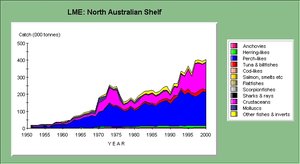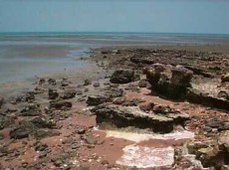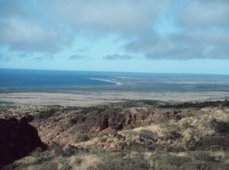North Australian Shelf
Contents
- 1 North Australian Shelf large marine ecosystem
North Australian Shelf large marine ecosystem
Introduction Location of the North Australian Shelf Large Marine Ecosystem (Source: NOAA (North Australian Shelf large marine ecosystem) )
The North Australia Large Marine Ecosystem (LME) is characterized by a tropical climate, and is positioned between the Pacific and the Indian Oceans. Nutrient enrichment and mixing are due to tidal mixing, monsoons and tropical cyclones in this LME. The Indonesian Throughflow, a warm-water current flowing from the Pacific into the Indian Ocean, plays a vital role in driving the world's climate system and is also of particular importance to Australia since it helps warm the sea surface of the Indian Ocean. LME articles pertaining to this LME include FAO, 2003.
Productivity
The LME extends from the Timor Sea to the Torres Strait and includes the Arafura Sea and Gulf of Carpentaria. It is bordered by the Timor Trough to the North. A vast continental shelf links Australia with Indonesia and Papua New Guinea. The LME’s Australian coastline is complex and rather poorly known. Supra-tidal mudflats are found along the arid and dry-tropical coastline of the southern Gulf of Carpentaria. The area has a monsoonal climate and tropical cyclones are common seasonal events. High monsoonal summer rain and dry winters result in gray mud sediments inshore and well-developed mangrove creeks. Tropical cyclones in this region have a pronounced effect on the continental shelf and on coastal marine ecosystems. The rainfall that accompanies cyclonic weather systems can be a major source of freshwater to the region, causing widespread though episodic flooding. Temperature and salinity measurements of the Indonesian Throughflow and the South Equatorial Current were made as part of the World Ocean Circulation Experiment (WOCE). Flats in the Gulf of Carpentaria concentrate salt and nutrients for extended periods following tidal inundations and rainfall, then release salty, nutrient-laden water into the coastal zone. The quantitative contribution of these events to the coastal zone is not well known. The North Australia Large Marine Ecosystem is considered a Class I, high productivity (>300 grams of carbon per square meter per year) ecosystem based on SeaWiFS global primary productivity estimates. Nutrient discharge from rivers is restricted to the summer wet season and is highly variable. Tidally induced mixing is a major contributor to the nutrient dynamics of this LME. In these systems, bottom friction acts in a manner analogous to wind stress on the surface to mix the water column. For information on the marine environment around Australia, see the CSIRO website. For a general understanding of oceanographic processes affecting the nutrient dynamics and productivity of Australian marine ecosystems, read the State of the Environment Report. For more information on productivity, see Furnas, 2002.
Fish and Fisheries
 LME: North Australian Shelf (Source: NOAA)
LME: North Australian Shelf (Source: NOAA) Fish stocks in the North Australia LME are small but diverse. The level of endemicity in northern Australian LMEs is low, with most species distributed widely in the Indo-West Pacific region. Commercial fisheries (Fisheries and aquaculture) are based on the Northern Prawn (Arafura Sea), mud crab, barramundi, salmon, shark, Spanish mackerel, as well as snappers and reef fish. The Northern Prawn in the Arafura Sea is almost fully exploited. Catch trends are very diverse. The Food and Agriculture Organization (FAO) 10-year trend shows a slight increase from 75,000 tons in 1990 to 80,000 tons in 1999 (see FAO, 2003). There is a very high percentage of crustacean catches (46%), and molluscs (16%). Until recently, fisheries resources were usually managed in units termed as a fishery. Under the Environment Protection and Biodiversity Conservation Act 1999 (the EPBC Act), the Commonwealth Government now has a framework that helps it to respond effectively to current and emerging environmental problems, and to ensure that any harvesting of marine species is managed for ecological sustainability. For detailed fish catch statistics for this LME, see data collected by the University of British Columbia Fisheries Center. A graphical representation of the data is presented above. FAO also provides information on Australia’s fisheries and the characteristics of the industry.
Pollution and Ecosystem Health
The LME is threatened by an increase in shipping and by the transportation of oil. Ships empty of cargo that enter the ports of Northwest Australia are ballasted with water collected in the last port of call. This ballast water has been shown to contain organisms including bacteria, viruses, algal cells, plankton, and the larval forms of many invertebrates and fish. There are accidental discharges of contaminants, such as spills and shipping accidents. The dominant human impacts are related to fisheries (Fisheries and aquaculture) and terrestrial [../156353/index.html runoff from deforestation, overgrazing and certain agricultural practices. Compared with most countries, however, these impacts remain few. Population densities are low in all coral reef areas, while the location of many reefs at some distance from the shore further protects them from human impacts. For more information on marine pollution in this LME, see Environment Australia and a technical paper from EA on marine disturbances.
Socioeconomics
 (Source: NOAA)
(Source: NOAA) Thousands of people are involved in the fisheries (Fisheries and aquaculture), aquaculture and processing sectors of the economy. The FAO (Food and Agriculture Organization (FAO)) provides information on the characteristics and socioeconomic benefits of Australia’s fishing industry. There are significant aquaculture activities based on oyster pearls, prawns and barramundi. Industry, shipping and tourism are major economic activities. Marine and coastal-based forms of tourism are important in this LME both in terms of domestic and international tourism. A significant proportion of the Australian population is involved in recreational fishing, surfing, wind surfing, diving, snorkeling, and boating. Tourists from overseas prize the [[coral reef]s] and the natural and unspoilt marine environment. There are, however, social, cultural, economic and environmental impacts caused by tourism. Tourism may affect the lifestyle of residents in ways they perceive as intrusive. Negative social impacts may include real or perceived increases in crowding, prices, or crime, as well as increased conflict between commercial, recreational and indigenous interests. Australia’s Aborigines, and the Torres Strait Islanders who occupy parts of the far northeast of the land area, have traditionally made considerable use of reef resources. Arnhem Land is an aboriginal reserve.
Governance
 (Source: NOAA)
(Source: NOAA) The North Australia LME lies off the coast of the states of Western Australia, Northern Territory and Queensland, opposite the country of Indonesia. Some governance issues in this LME pertain to the Aboriginal coastal populations who have considerable rights regarding their traditional use of the [[reef]s]. However, their numbers are now very low. In terms of fisheries (Fisheries and aquaculture) management, Australian fisheries resources are managed under both Commonwealth and State/Territory legislation. The demarcation of jurisdiction and responsibilities among these various governments has been agreed to under the Offshore Constitutional Settlement (OCS). Under OCS, the states and territories have jurisdiction over localized, inshore fisheries. The Commonwealth has jurisdiction over offshore fisheries or fisheries extending to waters adjacent to more than one state or territory. Each government has separate fisheries legislation and differing objectives. Transboundary fisheries and foreign fisheries are managed by the Commonwealth fishery agencies. An important goal is to ensure that the exploitation of fisheries resources is conducted in a manner consistent with the principles of [[ecological]ly] sustainable development. This includes the need to assess the impact of fishing activities on non-target species and the long-term sustainability of the marine environment. For more information on the governance of Australia’s fisheries, see FAO (Food and Agriculture Organization (FAO)) fisheries literature. Reserves have been declared to help protect rocky shore habitats and marine life, provide opportunities for research and education, conserve Australia’s cultural heritage and help boost ecotourism. The marine tourism industry has produced a code of conduct that covers issues such as anchoring, removal of rubbish, fish feeding and the preservation of world heritage values. Australia declared a 200 nautical-mile Exclusive Economic Zone in 1978. Australia is party to the following international agreements: Antarctic-Environmental Protocol, Antarctic Treaty, Biodiversity, Climate Change, Endangered Species, Environmental Modification, Hazardous Wastes, Law of the Sea, Marine Dumping, Marine Life Conservation, Nuclear Test Ban, Ozone Layer Protection, Ship Pollution, Tropical Timber 83, Wetlands, and Whaling.
References
Articles and LME VolumesFAO (North Australian Shelf large marine ecosystem) , 2003. Trends in oceanic captures and clustering of large marine ecosystems - 2 studies based on the FAO capture database. FAO fisheries technical paper 435. 71 pages.
Other References
- Furnas, M. J., 2002. Land-sea interactions and oceanographic processes affecting the nutrient dynamics and productivity of Australian marine ecosystems.
- Maclean, J.L., 1989. Indo-Pacific red tides, 1985-1988. Marine Pollution Bull. 20(7):304-310.
- Pogonoski, J.J., D.A.Pollard and J.R.Paxton, 2002. Conservation Overview and Action Plan for Australian Threatened and Potentially Threatened Marine and Estuarine Fishes (pdf). Environment Australia, February 2002.
- Sainsbury, K.J., 1988. The ecological basis of multispecies fisheries, and management of a demersal fishery in tropical Australia. In J.A. Gulland (ed.), Fishery population dynamics: The implications for management. John Wiley and Sons, New York. pp. 349-382. ISBN: 0471911518
- State of the Environment Report
| Disclaimer: This article is taken wholly from, or contains information that was originally published by, the National Oceanic and Atmospheric Administration (NOAA). Topic editors and authors for the Encyclopedia of Earth may have edited its content or added new information. The use of information from the National Oceanic and Atmospheric Administration (NOAA) should not be construed as support for or endorsement by that organization for any new information added by EoE personnel, or for any editing of the original content. |